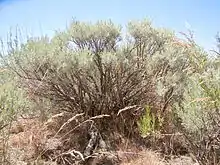Artemisia tripartita
Artemisia tripartita is a species of flowering plant in the aster family known by the common name threetip sagebrush.[1] It is native to western North America from British Columbia to Nevada and Montana to Colorado.[2] It covers about 8.4 million acres (3.4 million hectares) of the Rocky Mountains and Great Basin.[3]
| Artemisia tripartita | |
|---|---|
 | |
| Scientific classification | |
| Kingdom: | Plantae |
| Clade: | Tracheophytes |
| Clade: | Angiosperms |
| Clade: | Eudicots |
| Clade: | Asterids |
| Order: | Asterales |
| Family: | Asteraceae |
| Genus: | Artemisia |
| Species: | A. tripartita |
| Binomial name | |
| Artemisia tripartita | |
| Synonyms[1] | |
| |
This plant is an evergreen shrub up to 2 meters tall. The subspecies rupicola (Wyoming threetip sagebrush) is a dwarf subspecies with decumbent branches, spreading to about half a meter but growing only about 15 centimeters tall. The leaves are three-parted. The plant produces many seeds. It can also spread by sprouting from shallow roots and by layering.[3] The plant is aromatic.[1]
This plant is common and can be dominant in some regions, including the steppe of Washington, the sagebrush of southern Idaho, and the grassland and shrubland in western Montana. It grows on steep slopes and rocky, shallow soils. It tolerates dry soils well.[3]
- Subspecies[1]
- Artemisia tripartita subsp. rupicola Beetle - Wyoming, Colorado
- Artemisia tripartita subsp. tripartita - British Columbia, Washington, Oregon, Idaho, Montana, Wyoming, Utah, Nevada
References
- Flora of North America, Three-tipped sagebrush, Artemisia tripartita Rydberg
- Biota of North America Program 2014 county distribution map
- Tirmenstein, D. 1999. Artemisia tripartita In: Fire Effects Information System, [Online]. U.S. Department of Agriculture, Forest Service, Rocky Mountain Research Station, Fire Sciences Laboratory.
